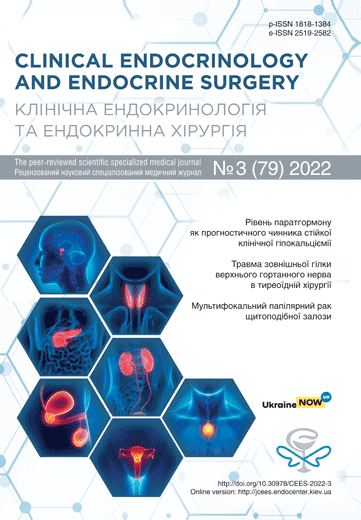Стан капілярної мікроциркуляції у хворих на цукровий діабет
DOI:
https://doi.org/10.30978/CEES-2022-3-40Ключові слова:
цукровий діабет, мікроциркуляція, капіляроскопія, мікроангіопатія, неінвазивна діагностикаАнотація
Мета роботи — вивчити зміни стану ендотелію на рівні мікроциркуляторної ланки системи кровообігу у хворих на цукровий діабет (ЦД) за допомогою капіляроскопії.
Матеріали та методи. Проведено клінічне обстеження 37 хворих на ЦД 1 та 2 типу віком від 21 до 65 років з різними виявами і тяжкістю захворювання. Хворих розподілили на дві групи. Першу (контрольну) групу утворили 12 хворих без ЦД, другу (основну) — 37 хворих на ЦД 1 (6 (16,2 %)) та 2 (31 (83,7 %)) типу. Оцінку стану мікроциркуляторного русла нижніх кінцівок визначали за допомогою капіляроскопії з використанням капіляроскопа Dino‑Lite MEDL4N5 Pro (Нідерланди).
Результати. Аналіз показників шкірної мікроциркуляції показав, що у хворих на ЦД мали місце як кількісні, так і якісні зміни порівняно з контрольною групою. Колір тла варіював від блідо‑рожевого до насичено‑червоного, при тяжкій формі мав сіруватий відтінок. Зафіксовано зміни розмірів і форми капілярів та капілярних петель які свідчать про процеси деструкції капілярів і неоангіогенезу. Найбільші структурні зміни капілярів виявляли у разі клінічно виразних симптомів. Малюнок венозної сітки був виражений сильніше, спастичні змінені та укорочені артеріальні коліна поєднувалися з розширеними та звивистими венозними, часто зустрічалися аневризматичні розширення та артеріо‑венозні анастомози. Крім того, капіляроскопічне обстеження дає змогу спостерігати зменшення кількості капілярів. Кровоток зернистий, уривчастий, швидкість його уповільнена.
Висновки. Виразність діабетичної мікроангіопатії прямо пропорційно залежить від тривалості захворювання. Використання показників шкірної мікроциркуляції дає змогу прогнозувати ймовірність розвитку діабетичної мікроангіопатії та ступінь її виразності у різні терміни захворювання.
Посилання
Sun H, Saeedi P, Karuranga S, et al. IDF Diabetes Atlas: Global, regional and country-level diabetes prevalence estimates for 2021 and projections for 2045. Diabetes Res Clin Pract. 2022;183:109119. doi: 10.1016/j.diabres.2021.109119.
Lin X, Xu Y, Pan X, et al. Global, regional, and national burden and trend of diabetes in 195 countries and territories: an analysis from 1990 to 2025. Sci Rep. 2020;10(1):14790. doi: 10.1038/s41598-020-71908-9.
Chawla A, Chawla R, Jaggi S. Microvasular and macrovascular complications in diabetes mellitus: Distinct or continuum? Indian J Endocrinol Metab. 2016;20(4):546-51. doi: 10.4103/2230-8210.183480.
Etienne I, Magalhães LVB, Cardoso SA, et al. Oxidative stress markers in cognitively intact patients with diabetic neuropathy. Brain Res Bull. 2019;150:196-200. doi: 10.1016/j.brainresbull.2019.06.001.
Zafrir B, Jaffe R, Rubinshtein R, Karkabi B, Flugelman MY, Halon DA. Impact of Diabetes Mellitus on Long-Term Mortality in Patients Presenting for Coronary Angiography. Am J Cardiol. 2017;119(8):1141-5. doi: 10.1016/j.amjcard.2017.01.004.
Deseive S, Straub R, Kupke M, et al. Impact of diabetes on coronary artery plaque volume by coronary CT angiography and subsequent adverse cardiac events. J Cardiovasc Comput Tomogr. 2019;13(1):31-7. doi: 10.1016/j.jcct.2018.09.008.
Love KM, Barrett EJ, Malin SK, Reusch JEB, Regensteiner JG, Liu Z. Diabetes pathogenesis and management: the endothelium comes of age. J Mol Cell Biol. 2021;13(7):500-12. doi: 10.1093/jmcb/mjab024.
Maldonado G, Guerrero R, Paredes C, Ríos C. Nailfold capillaroscopy in diabetes mellitus. Microvasc Res. 2017;112:41-6. doi: 10.1016/j.mvr.2017.03.001.
Maldonado G, Guerrero R, Paredes C, Ríos C. Nailfold capillaroscopy in diabetes mellitus. Microvasc Res. 2017;112:41-6. doi: 10.1016/j.mvr.2017.03.001.
Bakirci S, Celik E, Acikgoz SB, et al. The evaluation of nailfold videocapillaroscopy findings in patients with type 2 diabetes with and without diabetic retinopathy. North Clin Istanb. 2018;6(2):146-50. doi: 10.14744/nci.2018.02222.
Duke L. IDF’s strategy to tackle eye complications in people with diabetes. Diabetes Res Clin Pract. 2019;147:174-5. doi: 10.1016/j.diabres.2019.01.013.
Strain WD, Paldánius PM. Diabetes, cardiovascular disease and the microcirculation. Cardiovasc Diabetol. 2018;17(1):57. doi: 10.1186/s12933-018-0703-2.
Klonizakis M, Manning G, Lingam K, Donnelly R, Yeung JM. Effect of diabetes on the cutaneous microcirculation of the feet in patients with intermittent claudication. Clin Hemorheol Microcirc. 2015;61(3):439-44. doi: 10.3233/CH-141907.
Verma N, Liu M, Ly H, et al. Diabetic microcirculatory disturbances and pathologic erythropoiesis are provoked by deposition of amyloid-forming amylin in red blood cells and capillaries. Kidney Int. 2020;97(1):143-55. doi: 10.1016/j.kint.2019.07.028.
Kayser C, Bredemeier M, Caleiro MT, et al. Position article and guidelines 2018 recommendations of the Brazilian Society of Rheumatology for the indication, interpretation and performance of nailfold capillaroscopy. Adv Rheumatol. 2019;59(1):5. doi: 10.1186/s42358-018-0046-4.
Coppo C, Bonfanti D, Bo S, et al. Risk of microangiopathy in type 2 diabetes mellitus patients with or without chronic hepatitis C: Results of a retrospective long-term controlled cohort study. Dig Liver Dis. 2015;47(5):405-10. doi: 10.1016/j.dld.2015.01.157.
Raman R, Gupta A, Krishna S, Kulothungan V, Sharma T. Prevalence and risk factors for diabetic microvascular complications in newly diagnosed type II diabetes mellitus. Sankara Nethralaya Diabetic Retinopathy Epidemiology and Molecular Genetic Study (SN-DREAMS, report 27). J Diabetes Complications. 2012;26(2):123-8. doi: 10.1016/j.jdiacomp.2012.02.001.
Barchetta I, Riccieri V, Vasile M, et al. High prevalence of capillary abnormalities in patients with diabetes and association with retinopathy. Diabet Med. 2011;28(9):1039-44. doi: 10.1111/j.1464-5491.2011.03325.x.
Shaienko ZO. Laser doppler flowmetry as the advanced non-invasive method of evaluation оf microcirculation status in patients with diabetes mellitus. Clinical Endocrinology and Endocrine Surgery. 2021;4(76):44-50. DOI: http://doi.org/10.30978/CEES-2021-4-44 [in Ukrainian].
Uyar S, Balkarlı A, Erol MK, et al. Assessment of the relationship between diabetic retinopathy and nailfold capillaries in type 2 diabetics with a noninvasive method: nailfold videocapillaroscopy. J Diabetes Res. 2016;2016:7592402. doi: 10.1155/2016/7592402.
Kuryliszyn-Moskal A, Dubicki A, Zarzycki W, Zonnenberg A, Górska M. Microvascular abnormalities in capillaroscopy correlate with higher serum IL-18 and sE-selectin levels in patients with type 1 diabetes complicated by microangiopathy. Folia Histochem Cytobiol. 2011;49(1):104-10. doi: 10.5603/fhc.2011.0015.
##submission.downloads##
Опубліковано
Як цитувати
Номер
Розділ
Ліцензія
Авторське право (c) 2022 Автор

Ця робота ліцензується відповідно до Creative Commons Attribution-NoDerivatives 4.0 International License.





